Hook suspensions are the core of SuspenDC events. They are the main reason folks come! Hook suspensions may be performed in a wide variety of styles and intensities. Some suspensions feel more comfortable by design. Others challenge a person to their limits—by design. For an overview, check out this well-known poster of suspension positions (light version/dark version) compiled by Allen Falkner and illustrated by Shannon Larratt. Below, we’ll cover our most common suspensions in more detail, their advantages and challenges, variations, and ways you can condition your body to prepare for them.
If you are new to body modification, considering exploring options other than suspension before your first flight. Hook pulls and other ordeal experiences are intense, challenging, and powerful experiences in their own right, not merely stepping stones.
When you are ready to fly, reach out and discuss your vision with us. Sketches and photos are a starting point, but our goal is to help you fly your way.
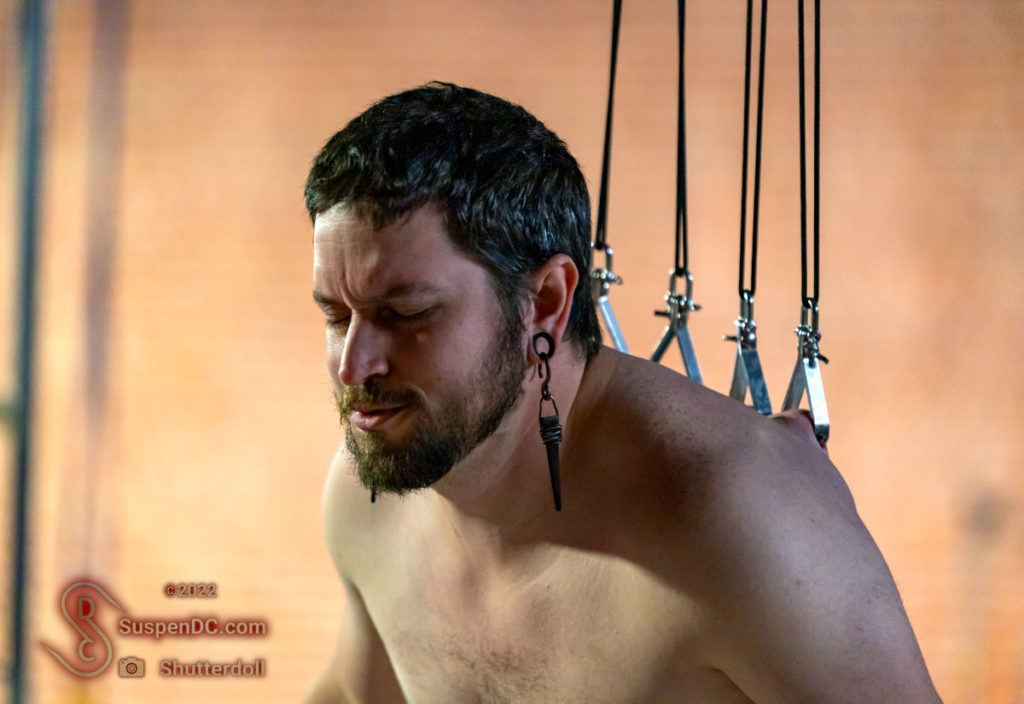
Suicide/Hanged Man
The vast majority of new flyers try this as their first flight. Four to six hooks are placed in a single or double horizontal row on the back, between the shoulder blades and lower ribs. The back bears all of the weight, and the posture is completely upright. While working to get off the ground, the flyer is encouraged to move, dance, and lean into the hooks in order to create an endorphin response in their body. As the flyer’s endorphin level rises, they take to the air and fly.
The ease of piercing, along with the variety of possible location adjustments, makes it a great first flight experience. Many frequent flyers use this flight plan as well because of the freedom of movement it allows while flying. Once in the air, the flyer’s arms and legs are free to use to dance, play, and even lift others.
Angel
In an angel suspension, six hooks are placed down the back in two columns, one on either side of the spine. The rigging fans out to either side, giving the appearance of wings. This holds the flyer upright or leaning slightly forward. Like a suicide/hanged man suspension, an angel suspension is loaded on the back, but the different directionality produces different sensations for some flyers.
This position is also well suited for a first flight due to the ease of piercing and freedom of movement it allows, and it remains popular for exploring and experienced flyers alike for the beauty and symbolism of its appearance.

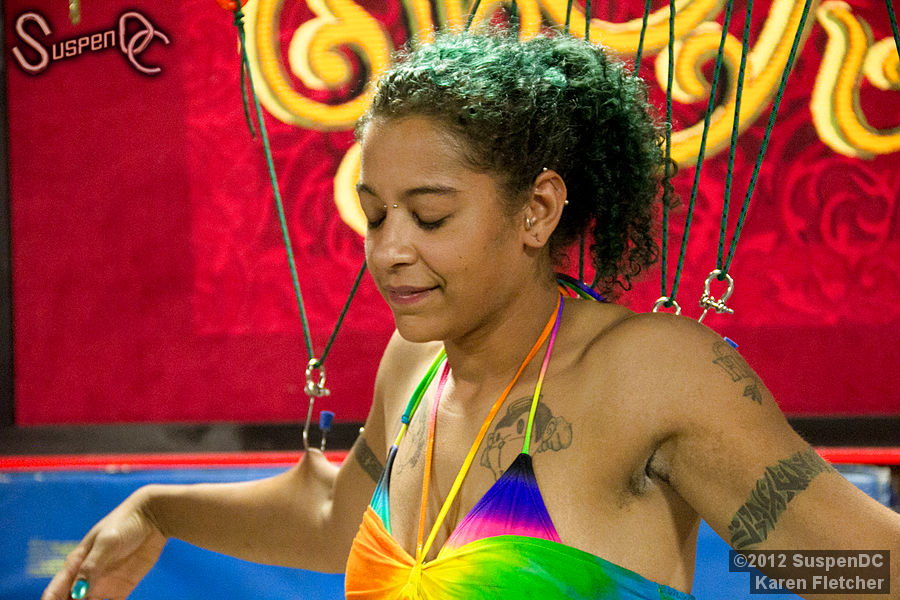
Crucifixion
A crucifixion suspension uses hooks placed horizontally across the back, as in a suicide/hanged man suspension, with one or more additional hooks in each arm, for a total of four to eight hooks. The resulting suspension holds the flyer upright with arms stretched out to each side. The legs are free to move, but the flyer’s arms are restricted to moving up and down along the plane of the body. Because of the dynamic rigging we use, an adventurous flyer can float their body up and down as they lower and raise their arms.
Piercing the arms may be more painful and stressful than the back for some flyers, but this position remains suitable for new and exploring flyers who seek a greater challenge or an opportunity to play with the physics of hooks and rigging.
Superhuman/Coma
The quintessential horizontal suspension. Eight to ten hooks, or more, are placed along the body from shoulders to calves. These are rigged to a long frame to hold the flyer in a horizontal position. The flyer may be face up (“coma”) or face down (“superhuman”).
The number of hooks used in this suspension can be a challenge for those who find piercing especially stressful, but the number of lift points makes for an easy flight once everything is in place.
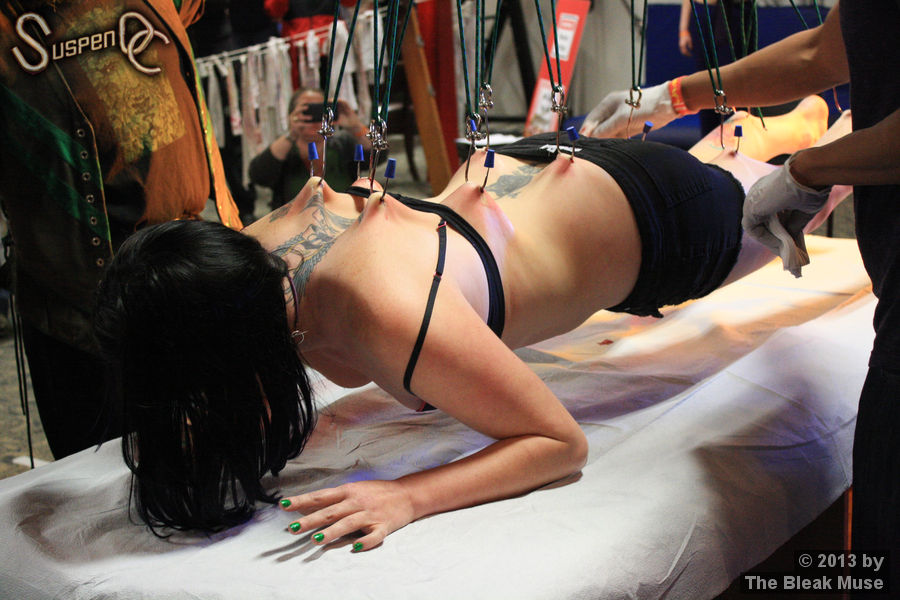
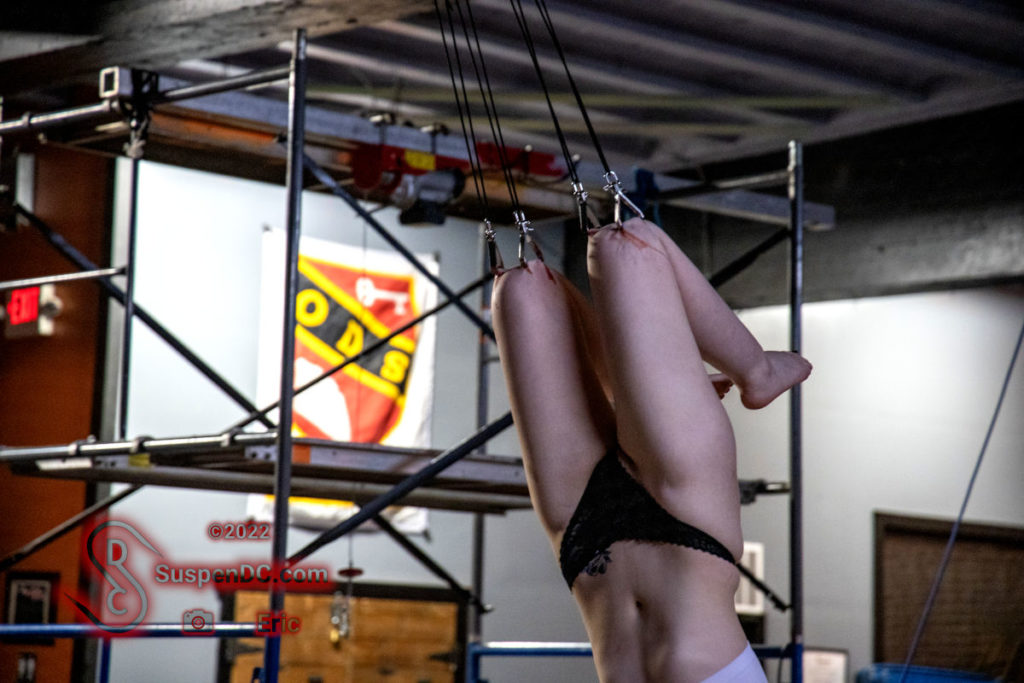
Knee
A knee suspension uses two or six hooks placed…well, at the knees. We prefer to keep the hooks on the femur side of the knee joint (one on each side of the leg or one just above the kneecap) out of an abundance of caution for the structure of the joint. This suspension has the flyer inverted in the air with their hands completely free.
This is a challenging way to fly due to limited movement and physical strain in the early stages of the process. We encourage anyone interested in this flight to develop their suspension experience with other positions before attempting it. Our experience shows us that someone familiar with their process and how they react to suspensions has a much better chance of success in more challenging positions. Preparing for this flight by practicing yoga postures like shoulder stands or hand stands can help train the body to lift into this position.
Scorpion
A scorpion suspension uses four to eight hooks to hold the flyer inverted in a backbend posture with feet over their head, giving the appearance of the stinging arachnid for which it is named. Hooks are placed in the flyer’s knees and back. For our team, a flyer lifts off into a knee suspension first, then moves into a backbend where the back hooks can be rigged into place.
This is a challenging flight plan. As with knees, we recommend that a flyer have previous suspension experience before attempting this. We encourage flyers to practice yoga backbends, like bridge, bow, or wheel pose, to prepare for this flight.
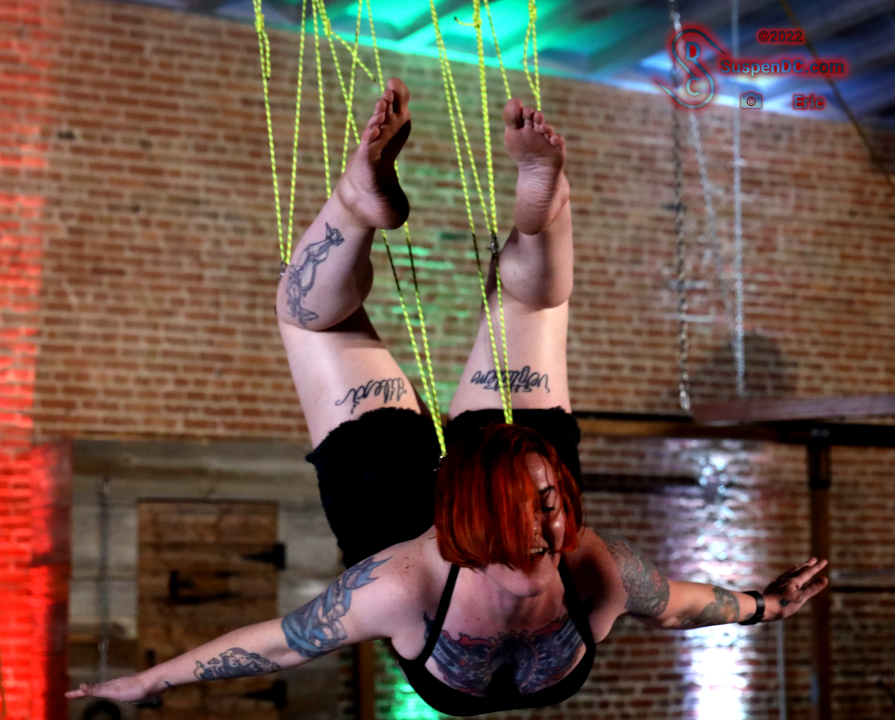
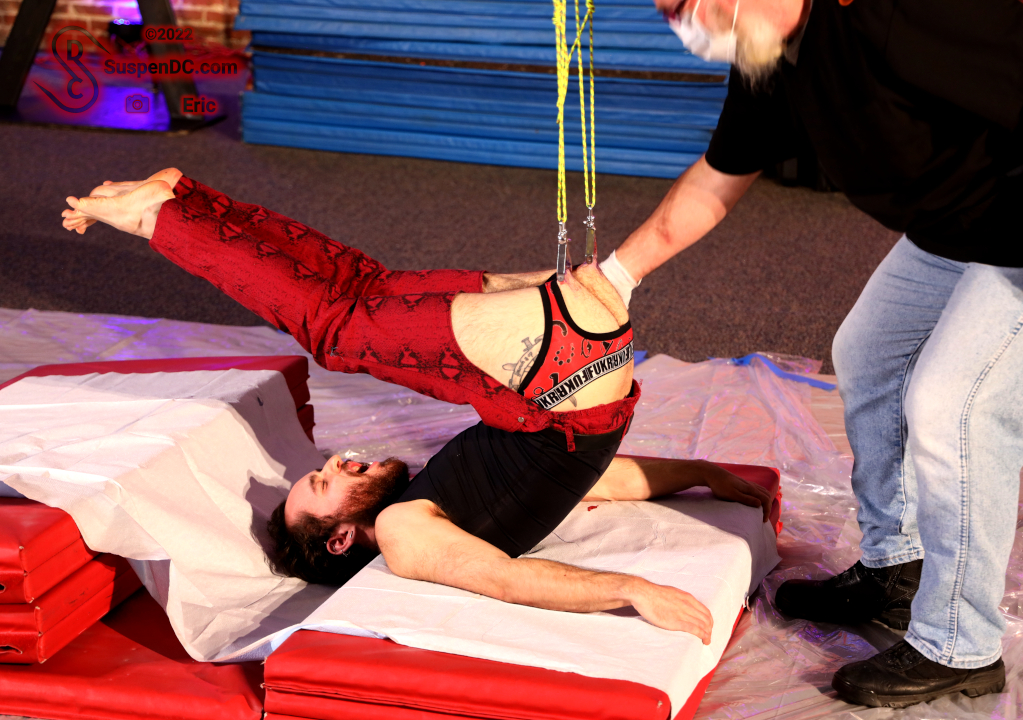
Asstronaut
In an asstronaut suspension, one or two hooks are placed in each buttock. The flyer lifts off from prone, all fours, or a shoulder stand. While in the air, the arms and legs are completely free.
This is a challenging suspension. We recommend flyers have experience with other suspensions before trying this flight plan. We encourage flyers to practice yoga postures like plow, shoulder stands, or hand stands to prepare for lift off.
Resurrection
A resurrection suspension uses two to eight hooks placed in columns on either side of the chest and abdomen. The flyer lifts off horizontally, face up. In the air, they may fly leaning back to remain horizontal or lift their chest to fly at an angle.
This flight is highly challenging. Abdominal lifts are extremely painful, and the lack of movement while lifting can result in a struggle even for experienced flyers. We recommend flyers have experience with several other suspensions before attempting this.

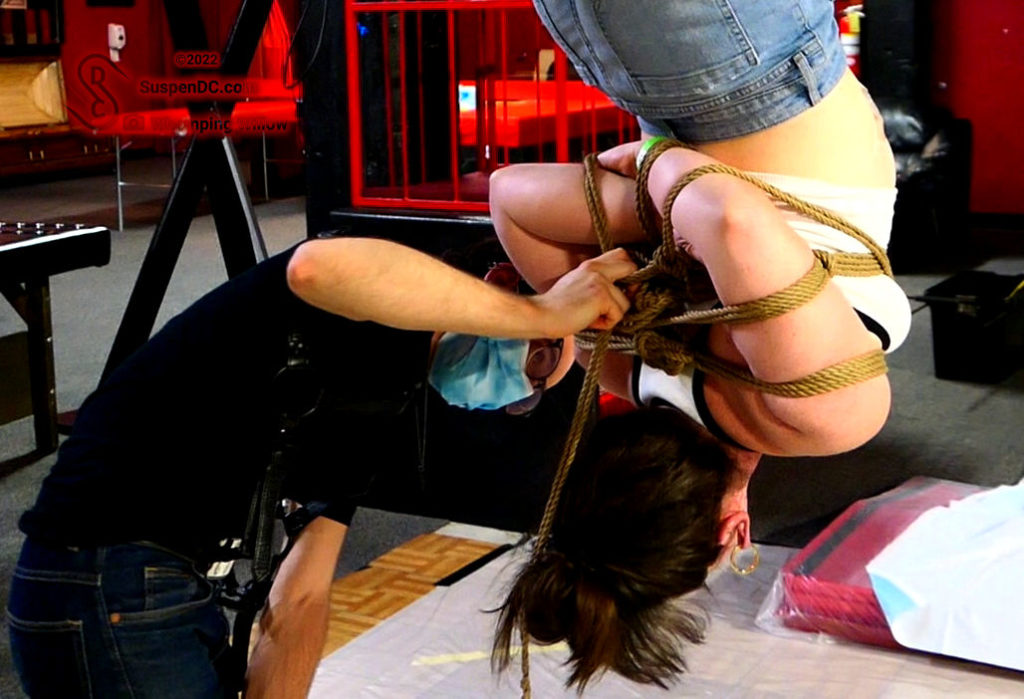
What Now?
As intense, profound, and life changing as hook suspensions are, they can also be the launching point for even greater exploration of the limits of endurance and creativity. The following are only a few ideas to inspire you.
Many experienced flyers experiment with cut transitions. In a cut transition, the number of rigged hooks is reduced in flight by cutting the lines on specific hooks. As an example, a scorpion suspension can have the lines to the back hooks cut, dropping the flyer into a knee suspension.
Hooks can also be combined with other intense experiences of sensation and pain. As a team of skilled bondage riggers and BDSM players, the SuspenDC crew has many skills we can bring to bear. Rope and hooks can be combined to create new experiences in the air. We can perform additional piercings with needles or jewelry to add to the endorphin rush or create beautiful works of body art. Virtually any other kind of BDSM play can be explored as part of a suspension to create infinite possibilities for your adventure. The SuspenDC team is here to help you realize your wildest hook suspension fantasies—what can you dream up?

